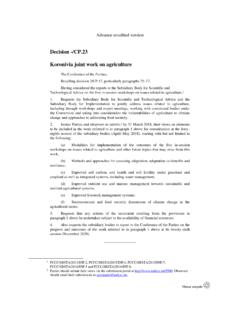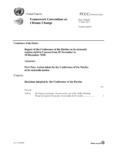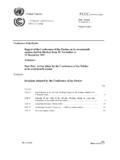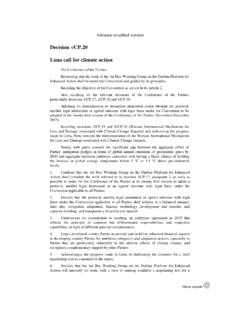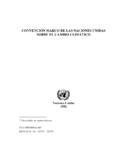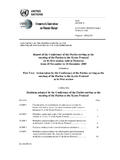Transcription of United Nations Framework Convention on Climate Change
1 United Nations Framework Convention on Climate Change Fact sheet: The need for mitigation Along with adaptation, mitigation is one of the two central approaches in the international Climate Change process. Mitigation involves human interventions to reduce the emissions of greenhouse gases by sources or enhance their removal from the atmosphere by sinks . A sink refers to forests, vegetation or soils that can reabsorb CO2. Carbon dioxide is the largest contributing gas to the greenhouse effect. In the 200 years since 1800, levels have risen by over 30%. Since levels of greenhouse gases are currently rising even more steeply, leading to the most dramatic Change in the atmosphere's composition in at least 650,000 years, international action on mitigation is urgently required.
2 The main greenhouse gases Six greenhouse gases covered by the United Nations Framework Convention on Climate Change (UNFCCC) and its Kyoto Protocol are: Gas Source Share of global emissions in 2004. Carbon dioxide (CO2) the consumption of 76,7%, energy from burning with from fossil fuels fossil fuel use deforestation Methane (CH4) agricultural activities energy production waste Nitrous oxide (N2O) mainly from agricultural activities Hydrofluorocarbons (HFCs) used as replacements for ozone-depleting substances Perfluorocarbons (PFCs). used in some Sulphur hexafluoride (SF6) industrial processes and in electric equipment November 2009 page 1 of 7. United Nations Framework Convention on Climate Change Share of global greenhouse gas emissions by major sectors Fossil fuel Waste Supply 3% Power Supply 5%.
3 Buildings 21%. 8%. Transport 13%. Industry agriculture 19%. 14%. Forestry 17%. Over the last three decades, all greenhouse gas emissions increased by an average of per year with CO2 emissions from fossil fuels use growing at per year. The largest growth in greenhouse gas emissions has come from energy supply and road transport. The current rates of deforestation, including tropical deforestation in South America, Africa and Asia, contribute to more than 20% of human-caused greenhouse gas emissions , making deforestation across the globe a significant contributor to human-induced Climate Change . Current mechanisms for emission reductions The ultimate objective of the United Nations Framework Convention on Climate Change (UNFCCC) is to stabilize atmospheric concentrations of greenhouse gases at a level that will prevent dangerous interference with the Climate system.
4 Concentration level before industrial 278 ppm revolution Concentration level 1990 350 ppm Concentration level (latest) 381 ppm The stabilisation level in the UNFCCC is not quantified. Discussions on future actions on Climate Change involve the question at what level stabilisation should be sought, and what constitutes dangerous . November 2009 page 2 of 7. United Nations Framework Convention on Climate Change According to the most stringent scenario of the IPCC, a long term goal in line with the latest science would include: A peak in emissions in the next 10 - 15 years And a decline of 50% over 2000 levels by 2050. This would stabilise emissions at around 450 parts per million CO2 eq in the atmosphere and correspond to a 2 - C rise in temperatures.
5 Commitments under the UNFCCC. The UNFCCC sets an overall Framework for international efforts to tackle the challenge of Climate Change . Parties to the Convention agreed to a number of commitments to address Climate Change : o To develop and periodically submit national reports containing information on the greenhouse gas emissions of that Party and describing the steps it has taken and plans to take to implement the Convention . o To put in place national programmes and measures to control emissions and to adapt to the impacts of Climate Change . o To promote the development and use of Climate -friendly technologies and the sustainable management of forests and other ecosystems. Developing countries (termed Non-Annex I countries under the Convention ), did not make commitments to reduce or limit greenhouse gas emissions at the time when the Convention was being negotiated.
6 The Convention applies the principle of common but differentiated responsibilities . As a result, industrialized countries, called Annex I Parties under the Convention , have additional commitments: o Undertake policies and measures with the specific aim of returning their greenhouse gas emissions to 1990 levels by 2000. o Provide more frequent and more detailed national reports and must separately provide yearly reports on their national greenhouse gas emissions . o Promote and facilitate the transfer of Climate friendly technologies to developing countries and to countries with economies in transition. November 2009 page 3 of 7. United Nations Framework Convention on Climate Change Commitments under the Kyoto Protocol The Kyoto Protocol shares the Convention 's ultimate objective.
7 It builds upon and enhances many of the commitments already in place under the Convention . Under the Protocol, 37 Annex I. Parties agreed to: o Specific binding emission targets to be achieved in the 2008 2012 commitment period, which will reduce emissions from these Parties by about 5% from 1990 levels. o Targets can be achieved by domestic action and by the use of international market mechanisms. (Note: in 2001, the US indicated it would not ratify the Protocol). The Market Mechanisms and the Carbon Market The Kyoto Protocol introduced three innovative mechanisms, by which Annex I Parties can lower their cost of achieving emissions targets. The mechanisms enable countries to access cost-effective opportunities to reduce emissions , or to remove carbon from the atmosphere in other countries: 1.
8 The Clean Development Mechanism (CDM). Funding sustainable development projects in non-Annex I Parties that reduce emissions (or enhance sinks through afforestation or reforestation.). 2. Joint Implementation (JI). Funding projects in countries with economies in transition (EITs). 3. emissions Trading, which allows Annex I Parties to trade credits or emission allowances among themselves. The Kyoto Protocol constitutes important progress in the global architecture, especially by initiating a global carbon market, but is a modest first step in Climate Change abatement. As the latest science points out, much more is needed. Progress made to date, before the first commitment period of the Kyoto Protocol The most recent UNFCCC emissions data is for 2007, includes the US and Australia and indicates the following: o Overall, Annex I (industrialised) Parties are on track to meet their emission reduction commitments, with a decrease of during the period 1990-2007.
9 November 2009 page 4 of 7. United Nations Framework Convention on Climate Change However, much of this reduction comes from the economic decline of economies in transition (countries in eastern and central Europe) in the 1990s and since 2000, the emissions have also been growing for this group (+3%). Projections for Kyoto Protocol ratifiers For the group of countries that have ratified the Kyoto Protocol, reductions of 11% are projected for the first Kyoto commitment period from 2008 to 2012, provided policies and measures planned by these countries are put in place. emissions from Developing countries emissions from developing countries are projected to significantly increase in the near future.
10 Many developing countries are taking mitigation action, including the scaling up of renewables in energy generation or energy efficiency targets. Future mitigation action in a post-2012 Framework Deep emission cuts by industrialised countries are needed and these countries must continue to take the lead in mitigation, given their historic responsibility and economic capabilities. A future Climate Change regime will require further engagement of developing countries, in particular those whose emissions already, or will in the near future, significantly contribute to atmospheric concentrations. This will be important given projected economic growth and energy demand in developing countries. Developing countries may need incentives to limit their emissions while safeguarding economic growth and poverty eradication.
